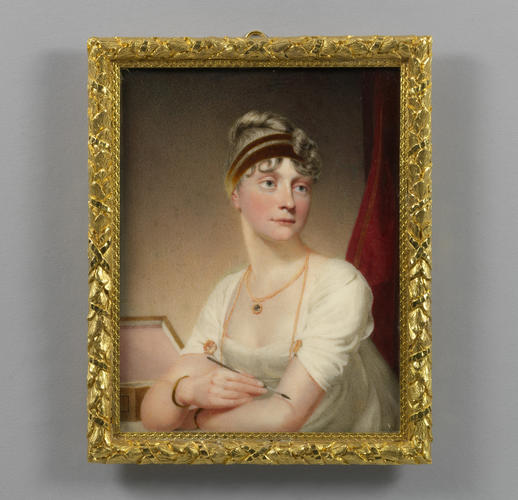-
1 of 253523 objects
Princess Sophia (1777-1848) 1807?
Watercolour on ivory | 10.7 x 8.2 cm (sight) (sight) | RCIN 420227
-
Princess Sophia was the fifth daughter of George III and Queen Charlotte and the favourite sister of the Prince of Wales and the Duke of Kent. Like her sisters, Sophia led a sheltered early life at Windsor Castle. The King was very attached to his daughters and reluctant to let them marry and leave home. Lord Melbourne later told Queen Victoria that when young, Princess Sophia was very pretty 'though very like a gipsy'. Princess Sophia's name was romantically attached to an equerry, Major-General Thomas Garth (1744–1829). She never married and after Queen Charlotte's death, lived in Kensington Palace, near the Duchess of Kent and the young Princess Victoria. Like the Duchess, she fell under the influence of Sir John Conroy, who took over her finances and this friendship alienated her from Victoria. Following her death in 1848, it became apparent that Conroy had embezzled most of her money.
Andrew Robertson (1777-1845) painted the prototype for this miniature in 1807 when he went to Windsor to paint the queen and the princesses. He explained in his diary why Princess Amelia is depicted in outdoor clothes: ‘Princess Amelia sat, lovely creature, fine features, melting eye, charming figure, elegant, dignified, finest hair imaginable – sits in her hat, cap, etc. however, because the Duke of Sussex [her brother] likes the dress – none of her fine hair seen. She is quite indifferent about her looks. She cannot be unconscious about her beauty, but no one ever thought less of it, or more careless of embellishment, further than her own comfort and respect for society requires’. Shortly before the princess died, Robertson was recalled to Windsor by George III to make replicas. The artist recorded: ‘I have to paint copies for all the family, that is, nearly all have given directions to that effect’. Henry Bone painted copies for the Prince Regent (RCIN421928 and 404272).
Andrew Robertson was born in Aberdeen, the son of an architect. He was very musical and became director of concerts in Aberdeen at the age of 16. He taught drawing, miniature painting and portraiture and received his Master of Arts in 1794 in Aberdeen. In 1801, Robertson went to London and entered the Royal Academy Schools, exhibiting in London and Edinburgh between1802 and 1842. In 1805, he was appointed miniature painter to the Duke of Sussex and exhibited portraits of him as lieutenant colonel of the Loyal North Britons, a volunteer regiment raised to repel Napoleon's threatened invasion of England. In 1807, he became secretary of the newly-founded society, the Associated Artists in Water Colour, where he exhibited portraits of the princesses in 1808.
The miniature is signed and dated on the right with the monogram AR 1800, and inscribed by the artist on the back in ink: painted by A. Robertson 33 Gerrard street London 1810, and in different handwriting: A. Robertson pinx.
Provenance
First recorded in the Royal Collection in 1851
-
Creator(s)
-
Medium and techniques
Watercolour on ivory
Measurements
10.7 x 8.2 cm (sight) (sight)
12.4 x 10.0 cm (frame, external)
Category
Object type(s)
Other number(s)
RL 1870 11.C.6Alternative title(s)
Princess Augusta (1768-1848), previously identified as
